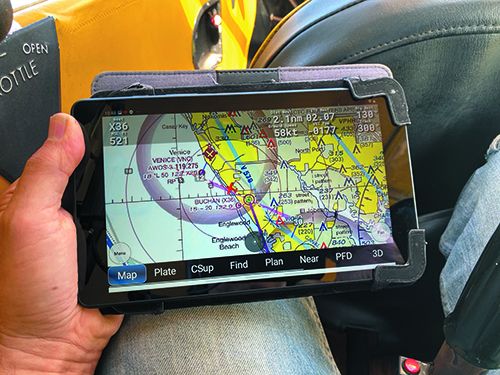COCKPIT TABLETS: GO BIG
Good article on the tablet computer user survey in the July 2020 issue of Aviation Consumer. I bought my first iPad in the second year of its introduction (never buy the first version of anything) to run the ForeFlight app. I use full-size iPads in the cockpit and my current cockpit model is a 2016 iPad Pro, with a 9.7-inch screen. I think the Mini is the best size for the cockpit, but I use mine for many other things, so I go big.
I buy a new iPad every four years and soon I will replace the 9.7-inch model with an iPad Pro with an 11-inch screen, which has similar external dimensions as the 9.7.
But the Pro model does come in two sizes, but that’s not what your article suggests. Sizing of iPads is confusing. Apple uses the diagonal measure of the display, and the borders keep getting smaller. Plus the height and width seem to be adjusted by a tenth of an inch up or down every year. The 11-inch model has roughly the same external dimensions as the original iPad.
As for memory, I currently have both U.S. and Canada data loaded in the ForeFlight Performance Plus program, which uses 32 GB. So for me at least, the entry-level model would not suffice because ForeFlight keeps adding features, but you can’t add memory to an existing iPad.
Last, it really is worth having the cellular version. It has a built-in GPS, but more importantly I can file flight plans while taxiing. I don’t need to do that often, but when I do it’s priceless. Also, recently as I copied my convoluted full-route clearance with the engine running ready for departure (I live in the Northeast), it was nice to see my clearance pop into the iPad from the cellular connection. With Garmin’s wireless Flight Stream interface, I pop it into my panel and off I go—no asking ATC to spell all the fixes. For that reason, the cellular option is worth the small cost.
Mike McNamara – Pottstown, Pennsylvania
MORE INSURANCE WOES
I’m a longtime subscriber to Aviation Consumer and read your recent e-newsletter report on used Piper Senecas with interest.
I just found out from my AOPA-brokered insurer that my renewal next month will require that I fly only with another named pilot. I called them (Assured Partners) and they said that this is because the market has hardened up for pilots over age 70 flying retractable-gear aircraft. I asked them if another carrier might be possible, and they said they’ll look into it, but they were pessimistic. Maybe try another broker, they hinted, but only after I pressed them on whether they have access to all carriers.
Your recent insurance articles warned about this worsening problem in the insurance market. What can I do? If I can’t get around this requirement, then I will have to stop flying retractable-gear aircraft.
Philip Steeves – via email
Yes, we saw this coming. The advice has generally been to not jump carriers because loyalty used to count for something, but you may have no choice. We’ve been hearing from other aging pilots of high-performance aircraft who aren’t being renewed—and these are loyal customers with pro experience (one recent customer has thousands of hours, holds an ATP and is a retired airline check captain) and no claims.
You have little to lose so you should certainly shop around, but expect a high premium and specific and stringent demands for recurrent training.
VORTEX GENERATORS FOR A CIRRUS
I love Aviation Consumer and read it cover to cover every month. Is there an STC for VGs in a Cirrus SR22? I asked my mechanic if he can install a set on my Cirrus and he said this modification isn’t approved. Are there any with an STC?
Michael Hubbell – via email
Not that we’ve seen. We checked with Micro AeroDynamics and BLR Aerospace, the big-two manufacturers, and neither offers VGs for Cirrus models. Back in 2012 Micro AeroDynamics said it was considering an STC for a Cirrus if it had one to work with.
CLEANING COMPOSITES
Your recent e-newsletter on aircraft cleaning said nothing about composite hulls. What about cleaning a Diamond or Cirrus?
Russ Irwin – via email
If it were ours, we would avoid cleansers containing silicon. A lot of the bottled automotive washes/detergents have silicon. Some Diamond service centers specifically mention the waterless Wash Wax All product partly because of its polymer ingredient, and we found it to be effective when we tested aircraft washes last year. A 32-ounce spray bottle of the stuff is $16.95.


